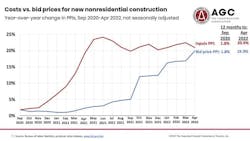Diesel Drives Construction Costs Up: AGC
The price index for diesel fuel jumped 86.5 percent in April compared to 12 months ago, one of many factors driving overall nonresidential input prices up 21 percent for the month, according to the Associated General Contractors of America. In its analysis of government data, AGC called upon the Biden Administration to end tariffs on key materials used in construction and “reconsider” Buy America regulations.
“Nonresidential contractors have endured 12 months of 20-percent increases in the cost of items they need to build projects,” said Ken Simonson, AGC’s chief economist, in a prepared statement. “While they have been able to pass some of those increased costs on to clients, most of those increases have come out of their own bottom line.”
The producer price index for inputs to new nonresidential construction—the prices charged by goods producers and service providers such as distributors and transportation firms—rose 0.8 percent from March to April and 20.9 percent over the past 12 months. An index for new nonresidential building construction—a measure of what contractors say they would charge to erect five types of nonresidential buildings—rose 4.1 percent for the month and 19.9 percent from a year earlier. April was the 19th consecutive month in which the cost index rose more than the bid-price index on a year-over-year basis, Simonson said.
A wide variety of inputs accounted for the increase in the cost index. The price index for diesel fuel jumped 86.5 percent over 12 months. The index for aluminum mill shapes climbed 44.8 percent. The index for architectural coatings such as paint soared 32.1 percent. There were increases of more than 20 percent in the indexes for plastic construction products, which rose 29.9 percent; truck transportation of freight, 27.4 percent; steel mill products, 25.1 percent; and roofing asphalt and tar products, 20.8 percent.
In addition, there were double-digit increases in several other price indexes that affect construction costs, Simonson noted. He cited as examples the index for insulation products, which rose 19.6 percent over 12 months; gypsum products, 17.8 percent; copper and brass mill shapes, 16.8 percent; paving mixtures and blocks, 14.4 percent; and concrete products, 10.9 percent.
Association officials said the best way to keep costs from rising even more is to allow contractors to buy materials from the widest possible range of suppliers and to eliminate measures that artificially inflate the cost of products. The officials urged the Biden administration to end tariffs that are restricting supplies of steel, aluminum, solar panels, and numerous other products. They also called on the administration to reconsider its “misguided” Buy America regulations that will make it much harder for firms to find and afford materials.
“Inflexible tariffs and overly restrictive regulations are making it harder for contractors to find and pay for key materials,” said Stephen E. Sandherr, CEO, in a statement. “Needlessly inflating the cost of construction and leaving employers with less money available to hire new staff is a bad way to rebuild infrastructure or boost the economy.”
Source: AGC
